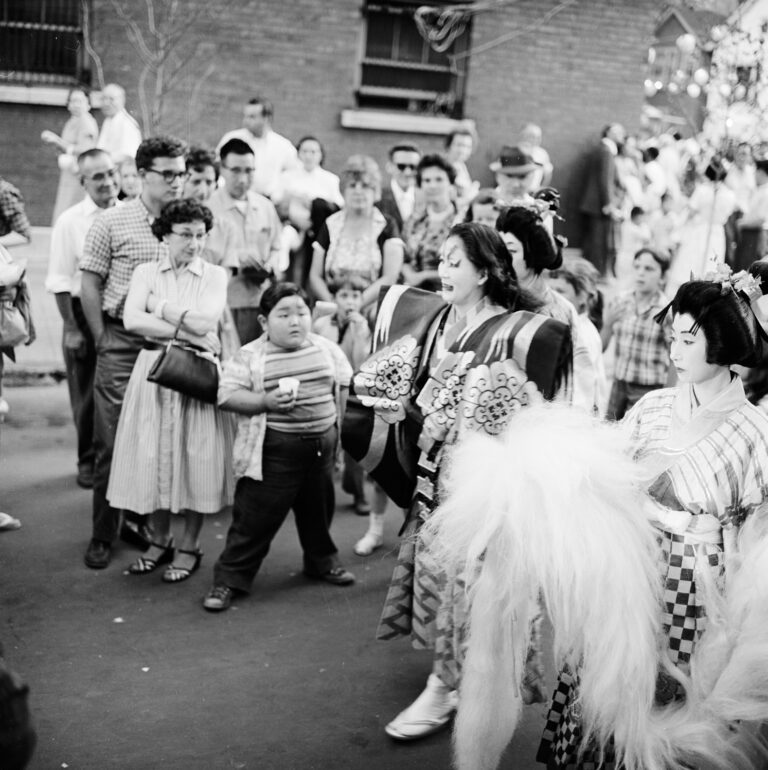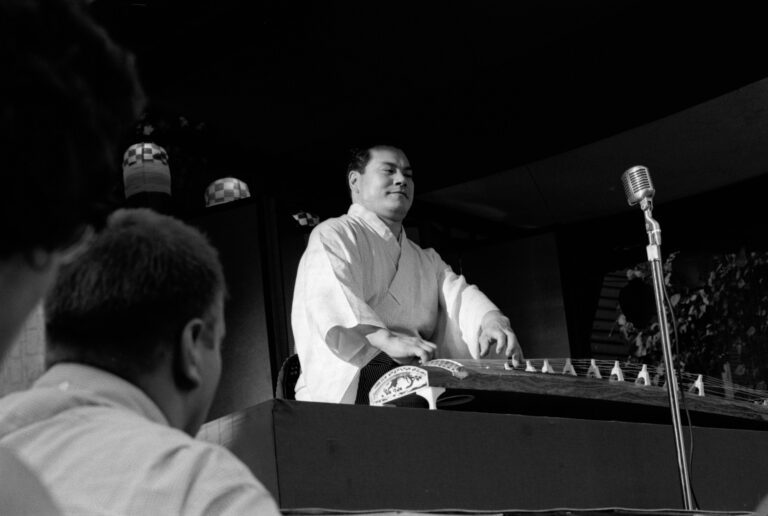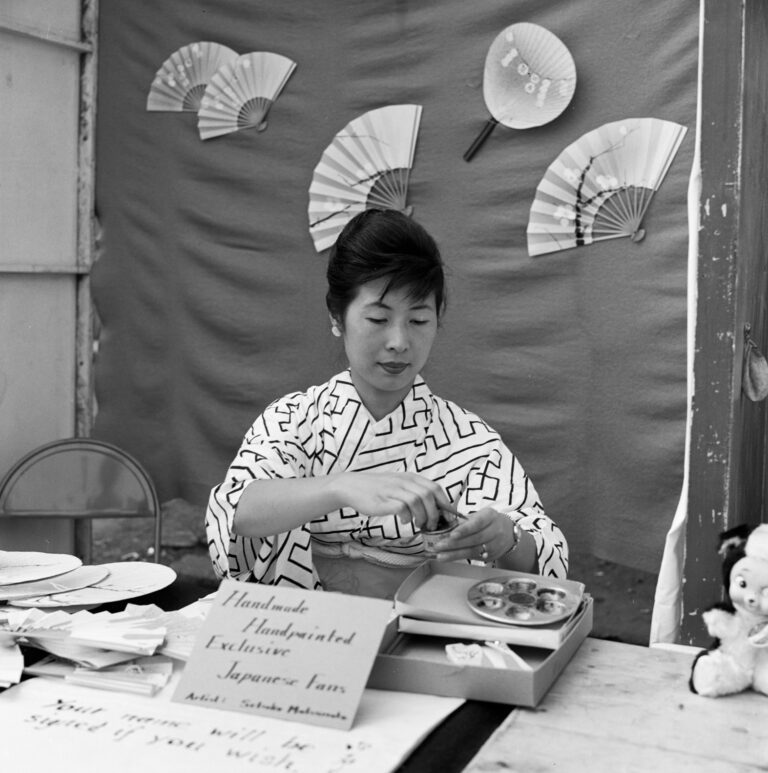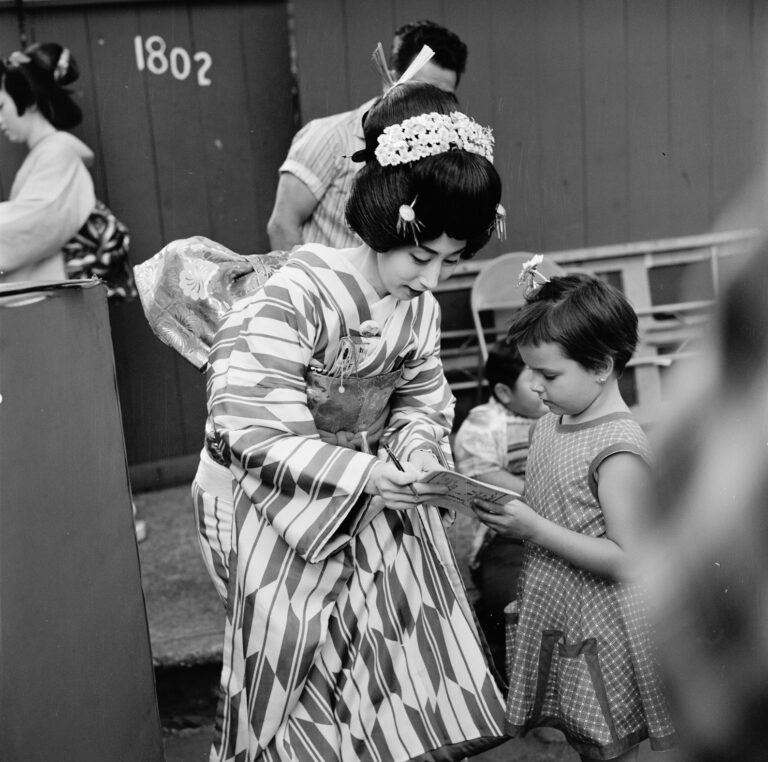
Performers in procession on a street in the Old Town neighborhood, Chicago, c. 1963. CHM, ICHi-132982; Raeburn Flerlage, photographer
The wafting aroma of chicken teriyaki, the rhythmic pulsing of taiko drumming, and the occasional murmur of Japanese on a languid summer day. For sixty-five years, the Ginza Holiday Festival has brought a bit of Japan to Chicago. The tradition.

A performer plays a koto (Japanese zither) at the Ginza Holiday Festival, Chicago, c. 1961. CHM, ICHi-117777; Raeburn Flerlage, photographer
In 1955, the Midwest Buddhist Temple in the Old Town neighborhood sought to create a fundraising event that would introduce Japanese food, culture, and entertainment to the public. With that in mind, the Ginza Holiday Festival was created. The festival’s name comes from the famous district in Tokyo, which for centuries was a destination for shopping and entertainment and still attracts millions of visitors.
Early Ginza Holiday Festivals were brightly lit with Japanese lanterns lining the street outside the temple and featured an authentically decorated stage and traditional red torii gates at the festival’s entrances. It was at the inaugural festival that its now-famous chicken teriyaki was introduced, a family recipe of an early temple member. Entertainment consisted of classical Japanese dancing, minyo (Japanese folk dancing), musicians such as shamisen and koto artists, and martial arts demonstrations, including judo, karate, and kendo.
In the 1970s, the Ginza Holiday Festival further enhanced its offerings by adding performances of taiko (Japanese drumming) and beginning a relationship with the Waza, an organization of more than 100 Japanese artisans who each master a craft that has been handed down through their families for 300 years since Japan’s Edo period.

A vendor selling hand-painted fans at the Ginza Holiday Festival, Chicago, c. 1963. CHM, ICHi-133016; Raeburn Flerlage, photographer
Each year, various Waza craftsmen travel internationally to share their artistry, and in August a small group of artisans visit the Ginza Holiday Festival, bringing unique art such as hand-thrown pottery, delicately detailed Japanese dolls, and silkscreened cloth towels. In addition to food, entertainment, and arts and crafts vendors, the Midwest Buddhist Temple’s resident minister opens the hondo (temple hall or chapel) and invites visitors to tour the temple and learn about Jodo Shinshu Buddhism.

A performer with a child during the Ginza Holiday Festival, Chicago, 1960. CHM, ICHi-132972; Raeburn Flerlage, photographer
For many Chicagoans, the Ginza Holiday Festival provides an opportunity to experience a different culture, connect with new acquaintances, and reconnect with old friends. See more images.
CHM Images
Peruse thousands of digitized prints and photographs at CHM Images, our online portal. Featured galleries include images from our newly acquired Chicago Sun-Times Photography Collection, Raeburn Flerlage’s work documenting the Chicago blues and folk music scene during the 1950s–1970s, and Declan Haun’s photography capturing the American Civil Rights Era. We encourage the use of our images for a variety of personal, nonprofit, and commercial purposes and all proceeds support the Chicago History Museum and our mission to share Chicago’s stories. See more images.